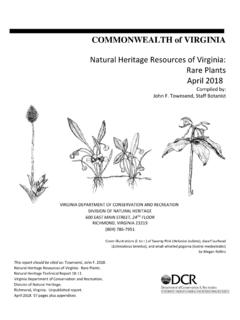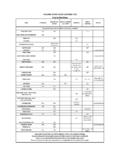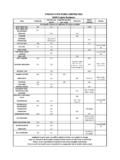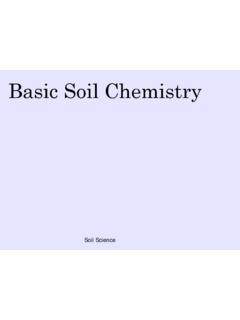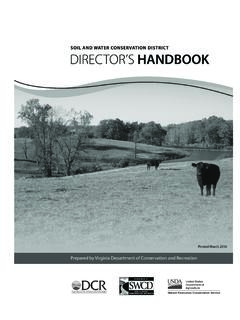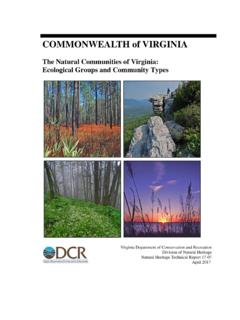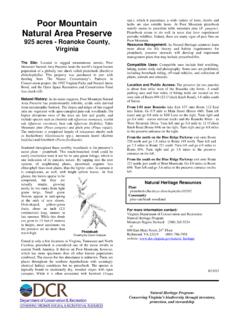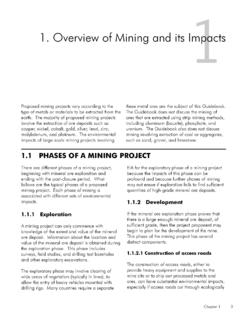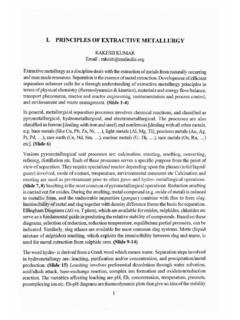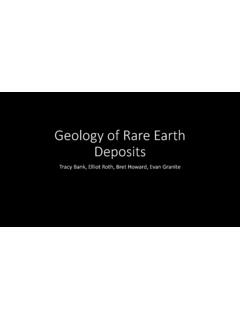Transcription of Basic Soil Science
1 Basic soil Science W. Lee Daniels 540-231-7175 See for more information on Basic soils! Well weathered (red, clayey) soil from the Piedmont of Virginia. This soil has formed from long term weathering of granite into soil like materials. A Horizon -- Topsoil B Horizon - Subsoil C Horizon (deeper) Native Forest soil Leaf litter and roots (> 5 T/Ac/year are bio-processed to form humus, which is the dark black material seen in this topsoil layer. In the process, nutrients and energy are released to plant uptake and the higher food chain. These are the natural soil cycles that we attempt to manage today. soil Profiles soil profiles are two-dimensional slices or exposures of soils like we can view from a road cut or a soil pit. soil profiles reveal soil horizons, which are fundamental genetic layers, weathered into underlying parent materials, in response to leaching and organic matter decomposition. Fig. -- Soils develop horizons due to the combined process of (1) organic matter deposition and decomposition and (2) illuviation of clays, oxides and other mobile compounds downward with the wetting front.)
2 In moist environments ( Virginia) free salts (Cl and SO4 ) are leached completely out of the profile, but they accumulate in desert soils. Master Horizons O horizon A horizon E horizon B horizon C horizon R horizon A E B C R O Master Horizons O horizon o predominantly organic matter (litter and humus) A horizon o organic carbon accumulation, some removal of clay E horizon o zone of maximum removal (loss of OC, Fe, Mn, Al, ) B horizon o forms below O, A, and E horizons o zone of maximum accumulation (clay, Fe, Al, CaC03, ) o most developed part of subsoil (structure, texture, color) o< 50% rock structure or thin bedding from water deposition Master Horizons C horizon o little or no pedogenic alteration o unconsolidated parent material or soft bedrock o < 50% soil structure R horizon o hard, continuous bedrock A vs. E horizon B B A A E E A vs. B horizon Subscripts Ap Bw1 Bw2 Ap Bt1 Bt2 Bt3 What s In soil ? soil is a three-phase system containing solids, liquids, and gasses that strongly interact with each other.
3 soil contains four components, mineral fragments, organic matter, soil air, and water. Figure Mineral Constituents The majority of soil solids are primary mineral fragments like quartz and feldspars along with synthesized secondary minerals like clays and iron oxides. Particles > 2 mm are largely unreactive and are called coarse fragments. Some important soil Physical Properties Color - as defined by the Munsell soil color book Texture the size distribution of the particles Structure how the particles are held together as aggregates Density pore space vs. solid space is in the soil Consistence resistance of aggregates to pressure soil Texture Particle size distribution. The relative proportions of sand, silt and clay. Sand 2 to mm gritty Silt to mm floury Clay < mm sticky Size separates (USDA) Fine earth fraction = sand, silt and clay Coarse fragments are particles > 2 mm. soil texture describes the fine earth fraction! Example: (see circle) 15% sand 15% clay 70% silt The Textural Triangle Quartz sand Montmorillonite clay soil Structure Primary soil particles (sands, silts, clays) become cemented together by organic matter and/or electrostatic forces over time.
4 These groupings are called aggregates or peds. The strength and shape of the peds greatly influence pore size distributions, water holding, gas exchange, and rooting. Strong, coarse, crumb structure (very rare) Weak, fine, granular (common in sandy soils) Moderate, medium, subangular blocky Prismatic macrostructure that subdivides into moderate medium subangular blocky structure. Note roots concentrated along macro-pores on ped faces. Prism broken apart Prism intact Compacted, platy replaced topsoil over highly compacted tails/slimes subsoil. Forest, silt loam Db = g/cm3 Pasture, silt loam Db = Mg/m3 Factors promoting aggregation Polyvalent cations (Al3+ or Ca2+) rather than monovalent exchangeable cations like Na+. Forces that act to physically push particles together, such as wet-dry (shrink-swell) and freeze-thaw cycles. Active microbial biomass generating humic substances that glue particles together. Physical binding effects of fine roots and fungal mycelia.
5 Burrowing animals move soil particles, and mix organic matter with mineral particles in their guts producing stable soil Bulk Density (Db) Average soil particle density is Mg/m3. soil Particle Density (Dp) solids soil of volumesoil of massdry Total soil volume = volume of soil solids and pore space for a sample as it would occur naturally in the ground. volumesoil totalsoil of massdry 3cmg3mMgOR Figure a Db = Mg/m3 Figure b Root limiting Db ranges from to ! Db = Mg/m3 at bottom of plow layer. See the roots turn sideways! Packing pores Interped pores Biopores Packing and texture affects soil porosity. Micropores are the packing voids between fine clay and fine silt grains. Macropores are found between peds of fine-textured soils or between sand grains in coarse textured soils. Total pore space does not indicate the size distribution of pores! Effects of lime and appropriate tillage in a garden soil . Lime + tillage when soil was moist (not wet).
6 Lime + tillage when soil was wet. Tillage has mixed effects on aggregation. In general, it decreases macropores. However, if we add lime plus organic matter as we till, the overall effects can be beneficial. No-till corn crop with thick surface layer of dead rye straw (killed in spring at planting) which serves as a mulch. This drastically limits erosion and promotes water infiltration, but also has significant effects on soil temperature! soil Organic Matter Humus is the dark brown to black complex decomposition product of organic matter turnover in soils. It is colloidal, much more highly charged than clay on a weight basis, and is typically what we report as organic matter content in soil testing programs. What Controls SOM Levels? Climate/Vegetation: Moist cool climates generate more OM inputs. Cool and/or wet soils limit microbial decomposition, leading to OM accumulation Grasslands vs. trees add detritus in differing ways: deeper thicker A s in Mollisols vs. distinct litter layers (O s) in Alfisols Figure What Controls SOM Levels?
7 Texture: Sandy soils allow ready losses of CO2 while clayey soils retain OM via humus clay associations. So, SOM increases with clay content! Drainage: Poorly drained wet soils retain SOM due the slow nature of anaerobic decomposition Figure ; SOM vs Texture for a group of similar soils. Figure Figure So, our ability to maintain SOM depends on dynamics of climate, drainage, texture, and perhaps most importantly, how we manage OM inputs vs. losses from the soil . Managing Organic Matter Maintain a continuous supply of fresh inputs. You can only maintain a certain level of OM in any soil based on climate, drainage, texture, You can waste a lot of energy and money trying to force OM levels above their equilibrium point! Managing Organic Matter Adequate N must be available in soils to sequester significant amounts of C. Without N, CO2 losses dominate. Higher levels of plant growth generally increase SOM levels Tillage decreases SOM levels Perennial vegetation increases SOM levels soil Hydrology soil and soil -landscape properties directly influence runoff/infiltration partitioning The soil is the major reservoir for water released back to the atmosphere via evapotranspiration The chemical quality of groundwater is directly controlled by soil chemistry Runoff vs.
8 Infiltration Precipitation falling on a soil landscape will first be subject to interception losses on vegetation of anywhere from 5 to 30% (light rain on thick canopy). When the rate of rainfall exceeds the infiltration rate of the soil , net runoff results. The infiltration rate is direct function of the degree of macroporosity of the surface soil . Runoff increases with slope (not shown) On a given slope, vegetation + soil structure enhance infiltration. Drainage, Storage and ET Once water infiltrates the soil , water in large macropores will continue to move downward due to gravity via drainage. This is the same concept as gravitational water. Water held up against leaching (see field capacity later) is referred to as soil storage available for evaporation (E) and transpiration (T) by plants. Figure Water cycles from the soil to the plant and then back to the atmosphere due to differences in what is known as water potential or free energy . Basically, the demand for water in the atmosphere (very low water potential) sucks water up the plant from the soil .
9 Figure a Practical Applications Water moves throughout the soil -plant-atmospheric system due differences in free energy always towards a more negative potential. Soils exert a much more negative potential on water than gravity, so the soil holds water until the plant root pulls it out due to atmospheric stress/suction. During the growing season in Virginia, particularly once we get plant canopy developed, it is very difficult to drive a wetting front all the way through the solum due to net ET demands of the vegetation. Water and Plant Growth When the soil is saturated, all macropores are filled, but gravitational water rapidly percolates downward from macropores. This state of saturation is also called maximum retentive capacity and is the maximum amount of water the soil can hold. Water and Plant Growth Once the soil loses its gravitational water downward (usually in minutes to hours), water that is held up the soil against leaching is bound there by matric forces which range from to bars in the thicker portions of water films extending into macropores.
10 The soil is now at field capacity. Water and Plant Growth As water continues to be evapotranspired away from the soil , the films of water around the soil surfaces become much thinner, so the matric forces holding water get much stronger (more negative). Finally, at about 15 bar potential (very thin water films), plants wilt because they can t pull water off the soil . This is the wilting point. Figure a 0 bars - to bars - 15 bars Water and Plant Growth So, overall, the most important concept here is that plant available water in a soil is taken as the difference between water held at Field Capacity and Wilting. Figure Figure Important Points Sandy soils hold relatively low amounts (< 10%) of total water at field capacity, but the vast majority of that water is plant available. Clayey soils hold relatively high amounts (>40%) of total water at field capacity, but the majority of that water is held at suctions below the wilting point, making it unavailable. soil pH Range.
